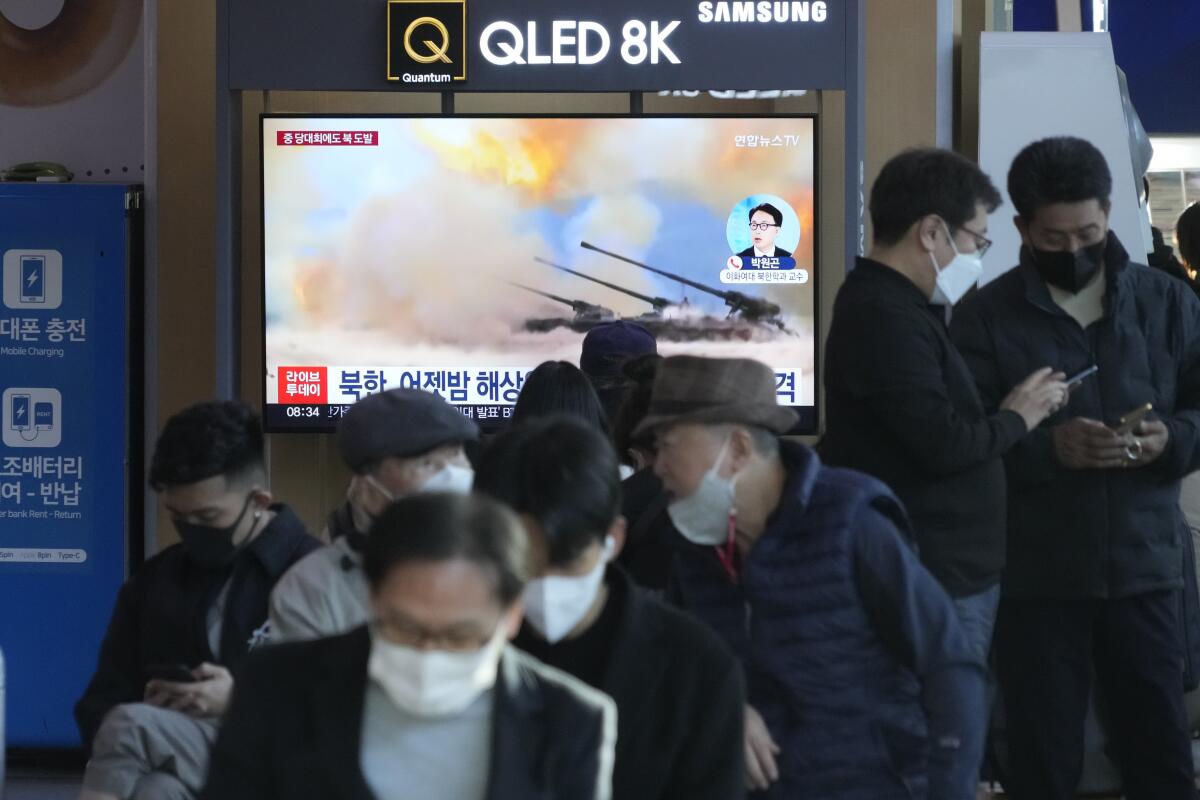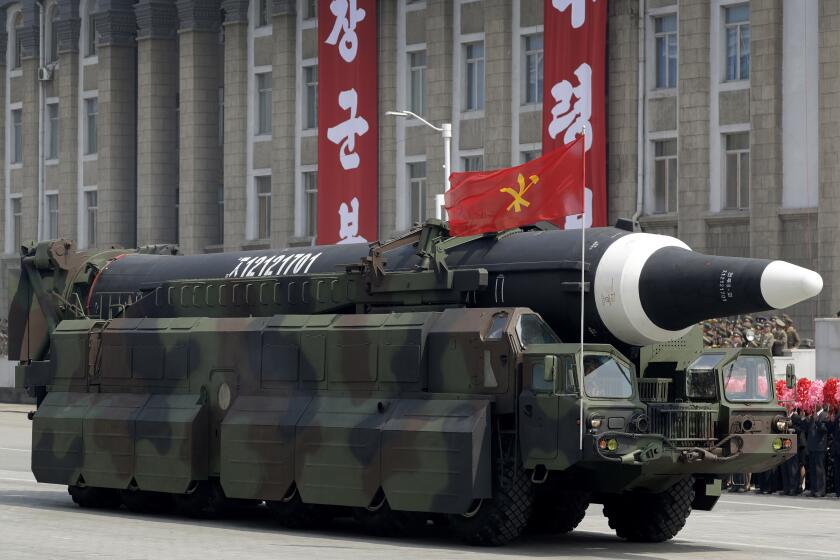North Korea fires 100 more artillery shells in response to South’s military exercises

- Share via
SEOUL — North Korea fired about 100 more artillery shells toward the sea Wednesday in response to South Korean live-fire drills at border areas as the rivals accused each other of dialing up tensions.
The drills conducted by both sides come amid heightened animosities over recent North Korean missile tests that it calls simulated nuclear attacks on South Korean and U.S. targets.
South Korea’s military detected the artillery being fired from a western North Korean coastal town, the South Korean Joint Chiefs of Staff said in a statement. On Tuesday night, North Korea fired about 100 shells off its west coast and 150 rounds off its east coast, the Joint Chiefs of Staff said earlier.
On both days, the North Korean shells landed in the northern parts of the maritime buffer zones the two Koreas created off their eastern and western coasts as part of agreements signed in 2018 to reduce tensions, according to the Joint Chiefs.
North Korea also fired hundreds of shells at the buffer zones Friday in its most significant direct violation of the 2018 agreement.
North Korea’s military said the launches were a warning against what it called provocative South Korean artillery firing drills along the border earlier this week.
Trade used to take precedence in Asia, but geopolitical tensions are now pushing nations into security blocs led by China and the United States.
“Our army strongly warns the enemy forces to immediately stop the highly irritating provocative act in the frontline areas,” an unidentified spokesperson for the general staff of the North’s Korean army said in a statement Wednesday.
South Korea’s Defense Ministry said it conducted artillery drills in land border areas as part of its annual military exercises. But it said the drills didn’t violate the 2018 accord because its shells didn’t land in the buffer zones.
South Korea’s Joint Chiefs of Staff warned North Korea to immediately stop provocations that threaten peace and stability on the Korean Peninsula. It added that it is boosting its military readiness and, in coordination with the United States, is closely monitoring North Korea’s moves.
There were no reports of violence between the two Koreas. But animosities could persist as North Korea will likely react to South Korea’s ongoing annual “Hoguk” field exercises with its own weapons tests. South Korean officials said the ”Hoguk” drills are aimed at improving a military readiness against North Korean nuclear and missile threats and involve an unspecified number of U.S. troops.
North Korea views regular South Korea-U.S. military training as rehearsal for an invasion. It said its recent barrage of missile tests were meant as a warning after earlier exercises involving a U.S. aircraft carrier.
North Korean leader Kim Jong Un signals more provocative tests to come after a series of missile launches designed to simulate use of nuclear weapons.
In parts of the so-called Hoguk drills that were open to the media, South Korean and U.S. troops built floating bridges on a river southeast of Seoul to let tanks and other armored vehicles move over them. South Korea’s army said Wednesday’s training was meant to deal with a hypothetical enemy attack that would leave some of the bridges over the river destroyed.
“It’s so far been extremely successful and demonstrated the strength of the ROK-U.S. alliance,” said Capt. Sean Kasprisin, a company commander at the U.S. military, using the initials of South Korea’s official name, the Republic of Korea. “We are definitely stronger together with the two nations.”
From Oct. 31 to Nov. 4, South Korea and the United States will also hold combined air force drills involving some 240 warplanes, including F-35 fighters operated by both nations. The drills are designed to assess the two countries’ joint operation capabilities and improve combat readiness, the South Korean military said Tuesday.
Chinese Foreign Ministry spokesperson Wang Wenbin said at a briefing Wednesday that Beijing hopes all relevant countries would keep trying to look for a political settlement to ease tensions on the Korean Peninsula.
North Korea has launched 15 missiles since it resumed testing activities Sept. 25. One of them was an intermediate-range ballistic missile that flew over Japan and demonstrated a range capable of reaching the Pacific U.S. territory of Guam and beyond.
Some foreign experts say North Korean leader Kim Jong Un would eventually aim to use his expanded weapons arsenal to pressure the United States and others to accept his country as a legitimate nuclear state and lift economic sanctions on the North.
The North’s artillery tests draw less outside attention than its missile launches. But its forward-deployed long-range artillery guns pose a serious security threat to the South Korean capital, Seoul, about 25 to 30 miles from the border with North Korea.
More to Read
Sign up for Essential California
The most important California stories and recommendations in your inbox every morning.
You may occasionally receive promotional content from the Los Angeles Times.













